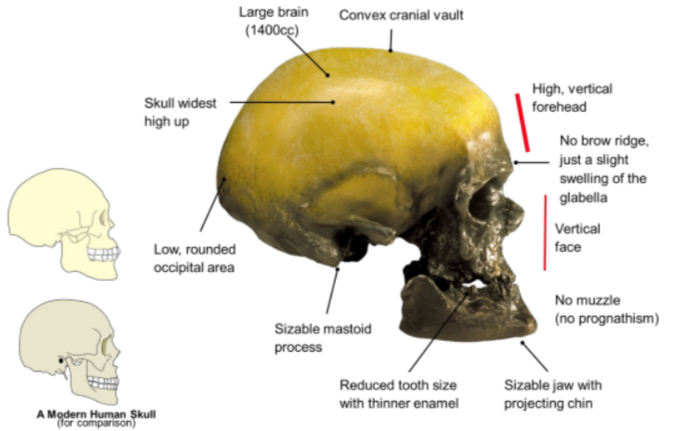BIO5 - Mid unit
5.0(1)
5.0(1)
Card Sorting
1/86
Study Analytics
Name | Mastery | Learn | Test | Matching | Spaced |
|---|
No study sessions yet.
87 Terms
1
New cards
Evolution by natural selection - List the principles
* All species produce more offspring than the resources can support
* There is natural variation between individuals of a species
* Individuals with advantageous genotypes will be more likely to survive & produce offspring
* Over subsequent generations, the frequency of the advantageous genotype increases, leading eventually to evolution of the species
* There is natural variation between individuals of a species
* Individuals with advantageous genotypes will be more likely to survive & produce offspring
* Over subsequent generations, the frequency of the advantageous genotype increases, leading eventually to evolution of the species
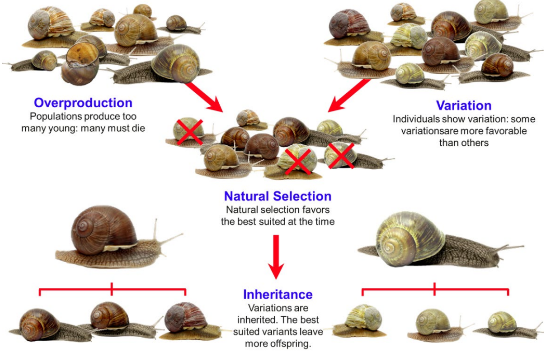
2
New cards
Requirements for life
* A source of energy
* The sun (top right) for photosynthetic organisms.
* Thermal vents (bottom right) for chemosynthetic organisms.
* A carbon source.
* Liquid water (e.g. geysers).
* The sun (top right) for photosynthetic organisms.
* Thermal vents (bottom right) for chemosynthetic organisms.
* A carbon source.
* Liquid water (e.g. geysers).
3
New cards
Processes needed for the origin of life
1\. The non-living synthesis of simple organic molecules (from primordial inorganic compounds)
2\. The assembly of these organic molecules into polymers
3\. The formation of polymers that can self-replicate (enabling inheritance)
4\. Packaging of these molecules into membranes with an internal chemistry different from their surroundings
2\. The assembly of these organic molecules into polymers
3\. The formation of polymers that can self-replicate (enabling inheritance)
4\. Packaging of these molecules into membranes with an internal chemistry different from their surroundings
4
New cards
Primordial sea → List conditions
* High volcanic activity
* High UV radiation (thin atmosphere)
* Lightning
* Water vapour, methane, ammonia, hydrogen
* High UV radiation (thin atmosphere)
* Lightning
* Water vapour, methane, ammonia, hydrogen
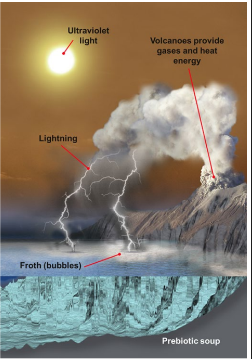
5
New cards
Undersea thermal vents → List conditions
* Life may have arisen at ancient volcanic vents which provided the necessary conditions for life:
* Gases
* Energy (heat)
* A possible source of catalysts (metal sulfides) for life to develop.
* Gases
* Energy (heat)
* A possible source of catalysts (metal sulfides) for life to develop.
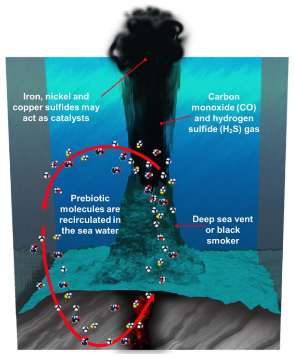
6
New cards
Panspermia
* Some bacteria survive similar to space conditions
* Comets contain organic material
* Could have delivered
* Comets contain organic material
* Could have delivered
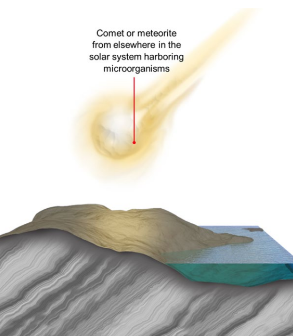
7
New cards
Proto-cell conditions
* A membrane separating the internal environment from the external environment
* Storage of specific biological molecules
* Ability to replicate
* Storage of specific biological molecules
* Ability to replicate
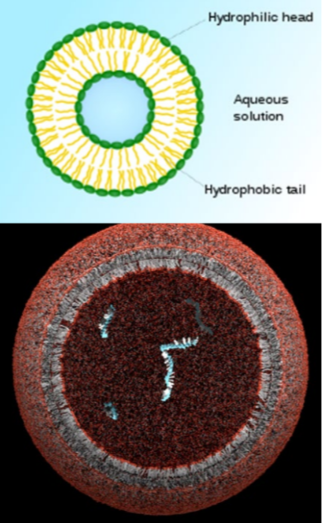
8
New cards
Ribozyme
RNA molecules have the ability to act both as a blueprint and as a catalyst
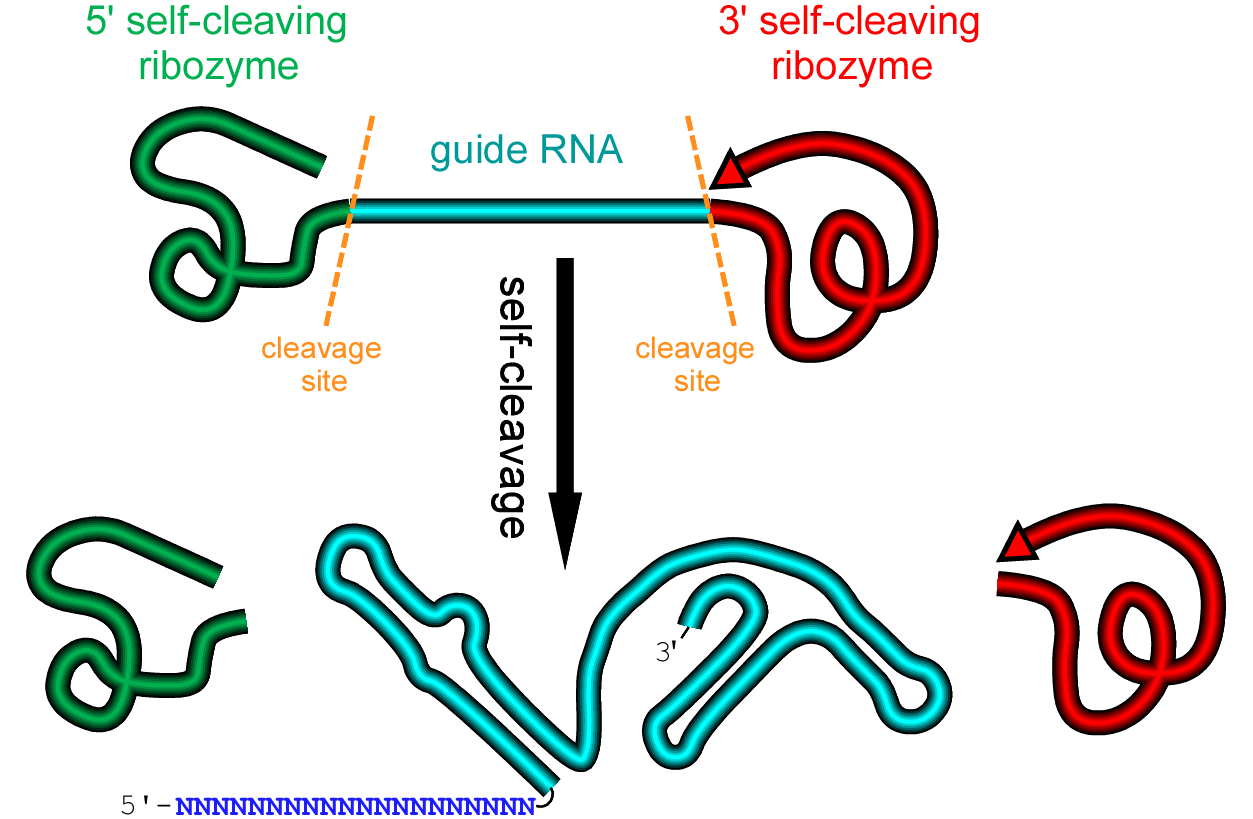
9
New cards
Relevant properties of RNA
1\. RNA can self-replicate
* RNA is able to store information in a sequence of four nucleotides (similar to DNA)
* Short sequences of RNA have been able to duplicate other molecules of RNA accurately
2\. RNA can act as a catalyst
* Modern cells use RNA catalysts (called ribozymes) to remove introns from mRNA and help synthesise new RNA molecules
* In ribosomes, rRNA is found in the catalytic site and plays a role in peptide bond formation
* RNA is able to store information in a sequence of four nucleotides (similar to DNA)
* Short sequences of RNA have been able to duplicate other molecules of RNA accurately
2\. RNA can act as a catalyst
* Modern cells use RNA catalysts (called ribozymes) to remove introns from mRNA and help synthesise new RNA molecules
* In ribosomes, rRNA is found in the catalytic site and plays a role in peptide bond formation
10
New cards
Earth’s history + Early life
Series of key events that occur
* Evidence for life in microbial mats such as stromatolites are multilayered sheets formed by microorganisms such as archaea and bacteria.
* Evidence for life in microbial mats such as stromatolites are multilayered sheets formed by microorganisms such as archaea and bacteria.
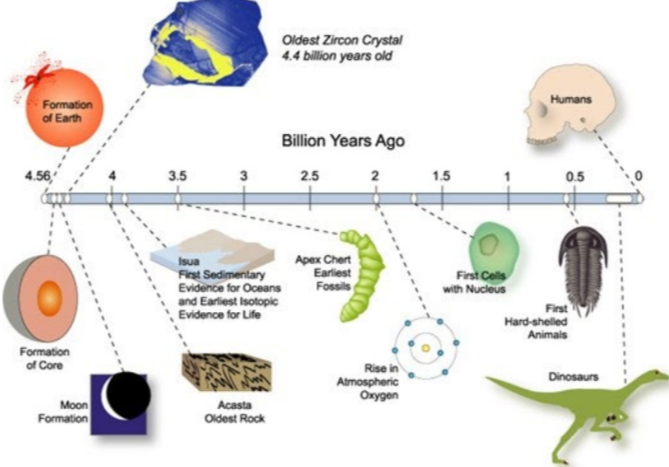
11
New cards
Oxygen enrichment
Oxygen producing bacteria evolved somewhere between 2.5 and 3.0 billion years ago that eventually became photosynthesis.
Transformed planet from an environment of very little free oxygen to one of continuously increasing levels.
* This led to some key events such as the production of oxidized compounds, the evolution of aerobic organisms, changing Earth's atmosphere.
* Formation of an ozone layer restricted UV radiation to allow for the proliferation of a wider range of life forms.
Transformed planet from an environment of very little free oxygen to one of continuously increasing levels.
* This led to some key events such as the production of oxidized compounds, the evolution of aerobic organisms, changing Earth's atmosphere.
* Formation of an ozone layer restricted UV radiation to allow for the proliferation of a wider range of life forms.
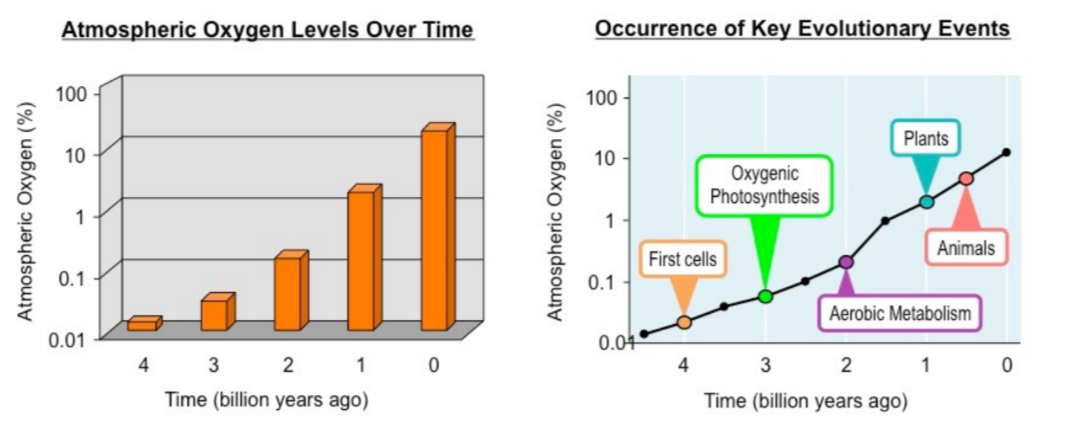
12
New cards
Origins of Eukaryotes
* First appeared \~2 billion years ago.
* evolved from large prokaryotic cells that ingested other prokaryotes.
* symbiotic relationship- endosymbiosis.
* Evidence of multicellular organisms first appeared around 1.1 bya, with abundant multicellular fossils (e.g. the Ediacaran fauna) present by 0.55 bya.
* evolved from large prokaryotic cells that ingested other prokaryotes.
* symbiotic relationship- endosymbiosis.
* Evidence of multicellular organisms first appeared around 1.1 bya, with abundant multicellular fossils (e.g. the Ediacaran fauna) present by 0.55 bya.
13
New cards
Endosymbiosis
Cell which lives inside another cell with mutual benefit
* Eukaryotic cells are believed to have evolved from early prokaryotes that engulfed other cells by phagocytosis
* Engulfed prokaryotic cell remained undigested as it contributed new functionality to the engulfing cell (e.g. photosynthesis)
* Cell lost some of its independent utility and became a supplemental organelle
\
Evidence in organelles:
* Membranes (double membrane bound)
* Antibiotics (susceptibility)
* Division (mode of replication)
* DNA (presence and structural composition)
* Ribosomes (size)
* Eukaryotic cells are believed to have evolved from early prokaryotes that engulfed other cells by phagocytosis
* Engulfed prokaryotic cell remained undigested as it contributed new functionality to the engulfing cell (e.g. photosynthesis)
* Cell lost some of its independent utility and became a supplemental organelle
\
Evidence in organelles:
* Membranes (double membrane bound)
* Antibiotics (susceptibility)
* Division (mode of replication)
* DNA (presence and structural composition)
* Ribosomes (size)
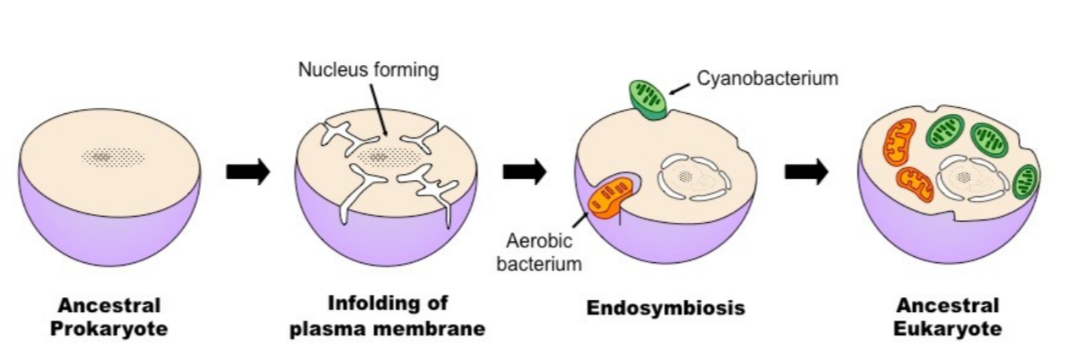
14
New cards
Stromatolite
Microbial mats such as stromatolites are multilayered sheets formed by microorganisms such as archaea and bacteria.
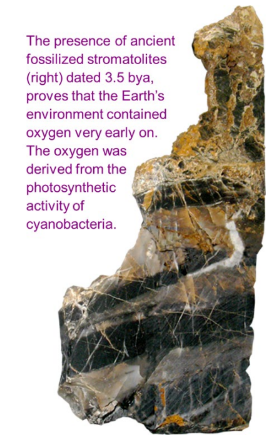
15
New cards
Oxygen Enrichment
* Theorised oxygen producing bacteria 2-3 billion years ago evolved through a process eventually known as photosynthesis
* Transformed the planet
* This led to some key events such as the production of oxidized compounds, the evolution of aerobic organisms, and the changing of the Earth's atmosphere. The subsequent formation of an ozone layer restricted UV radiation to allow for the proliferation of a wider range of life forms.
* Transformed the planet
* This led to some key events such as the production of oxidized compounds, the evolution of aerobic organisms, and the changing of the Earth's atmosphere. The subsequent formation of an ozone layer restricted UV radiation to allow for the proliferation of a wider range of life forms.

16
New cards
Endosymbiosis
* An endosymbiont is a cell which lives inside another cell with mutual benefit
* Eukaryotic cells are believed to have evolved from early prokaryotes that engulfed other cells by phagocytosis
* The engulfed prokaryotic cell remained undigested as it contributed new functionality to the engulfing cell (e.g. photosynthesis)
* Over generations, the engulfed cell lost some of its independent utility and became a supplemental organelle
* Eukaryotic cells are believed to have evolved from early prokaryotes that engulfed other cells by phagocytosis
* The engulfed prokaryotic cell remained undigested as it contributed new functionality to the engulfing cell (e.g. photosynthesis)
* Over generations, the engulfed cell lost some of its independent utility and became a supplemental organelle

17
New cards
Evidence for endosymbiosis
* Membranes (double membrane bound)
* Antibiotics (susceptibility)
* Division (mode of replication)
* DNA (presence and structural composition)
* Ribosomes (size)
* Antibiotics (susceptibility)
* Division (mode of replication)
* DNA (presence and structural composition)
* Ribosomes (size)
18
New cards
Direct fossil
Body fossils:
* Bones, teeth, shells, leaves
* Bones, teeth, shells, leaves
19
New cards
Indirect fossils
Trace fossils: Footprints, tooth marks, tracks, burrows, etc.
20
New cards
Fossil record
The totality of fossils, both discovered and undiscovered, is referred to as the fossil record
* Changes occurred in the features of living organisms (evolution) ◻
* new species emerging (divergence and speciation) and extinctions
* Demonstrates a change in an organism's characteristics from an ancestral form
* Changes occurred in the features of living organisms (evolution) ◻
* new species emerging (divergence and speciation) and extinctions
* Demonstrates a change in an organism's characteristics from an ancestral form
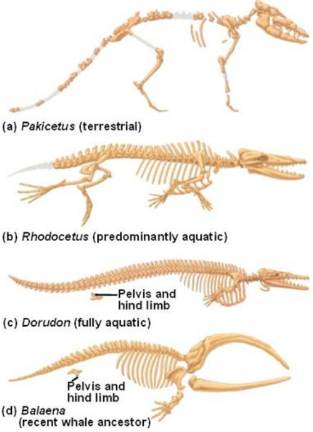
21
New cards
Law of fossil succession
* the age of the rock layer (strata) in which the fossil is found Sedimentary rock layers develop in chronological order, such that lower layers are older and newer strata form on top Each strata represents a variable length of time that is classified according to a geological time scale (eons, eras, periods)
* This chronological sequence of complexity by which characteristics appear to develop is known as the **law of fossil succession**
* Newer species likely evolved as a result of changes to ancestral species
* Transitional fossils demonstrate the intermediary forms that occurred over the evolutionary pathway taken within a single genus
* This chronological sequence of complexity by which characteristics appear to develop is known as the **law of fossil succession**
* Newer species likely evolved as a result of changes to ancestral species
* Transitional fossils demonstrate the intermediary forms that occurred over the evolutionary pathway taken within a single genus
22
New cards
Conditions for fossilisation
* Rapid burial (high pressure)
* Lack of oxygen / no decomposition by bacteria
* Preservation of remains (i.e. not consumed or removed by scavengers)
* Lack of oxygen / no decomposition by bacteria
* Preservation of remains (i.e. not consumed or removed by scavengers)
23
New cards
Biogeography
* Biogeography describes the distribution of lifeforms over geographical areas, both in past and present times
* Biogeography provides evidence for evolution because it suggests that closely distributed species share a common lineage
* If speciation was random, the distribution of structurally similar species would be expected to be scattered
* Biogeography provides evidence for evolution because it suggests that closely distributed species share a common lineage
* If speciation was random, the distribution of structurally similar species would be expected to be scattered
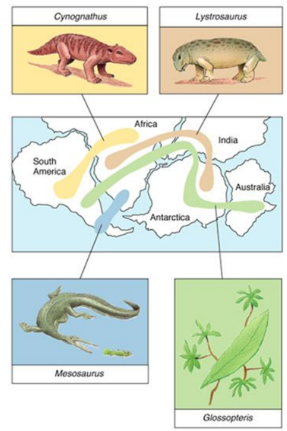
24
New cards
The centre of origin
* Each plant and animal species originated only once. The place where this occurred is the centre of origin.
* Related species are usually found in close physical proximity (supporting the concept of speciation via gradual divergence)
* Fossils found in a particular region tend to closely resemble the modern organisms of the region
* Related species are usually found in close physical proximity (supporting the concept of speciation via gradual divergence)
* Fossils found in a particular region tend to closely resemble the modern organisms of the region
25
New cards
Homologous structure
Anatomical features that are similar in basic structure despite being used in different ways are called homologous structures
Ex
* Tetrapods (organisms with 4 limbs) all have very similar bone structures in their limbs (pentadactyl), despite different functions for the limbs.
* This indicates a common ancestor, followed by evolutionary changes and natural selection.
Ex
* Tetrapods (organisms with 4 limbs) all have very similar bone structures in their limbs (pentadactyl), despite different functions for the limbs.
* This indicates a common ancestor, followed by evolutionary changes and natural selection.
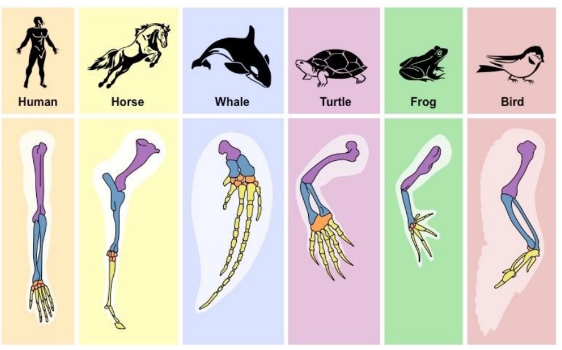
26
New cards
Analogous structure
* Analogous structures arise from different origins, usually via convergent evolution due to similar niches/selection pressures
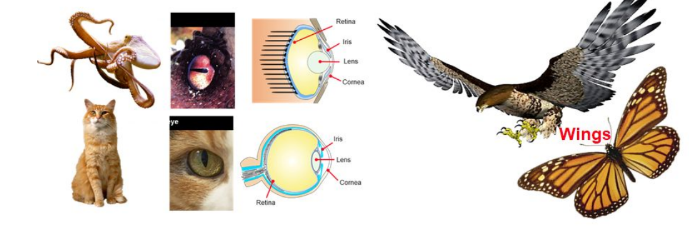
27
New cards
Vestigial structure
Vestigial structures are small remnants of organs which previously in a species’ evolutionary history were useful.
* Vestigial wings in the kiwi
* Vestigial pelvic bones in snakes and whales
* Vestigial appendix in humans
The structures generally do not completely disappear as; the selection pressure for that to happen is not there, the genes for their presence are still active, or they still have a minor function.
* Vestigial wings in the kiwi
* Vestigial pelvic bones in snakes and whales
* Vestigial appendix in humans
The structures generally do not completely disappear as; the selection pressure for that to happen is not there, the genes for their presence are still active, or they still have a minor function.
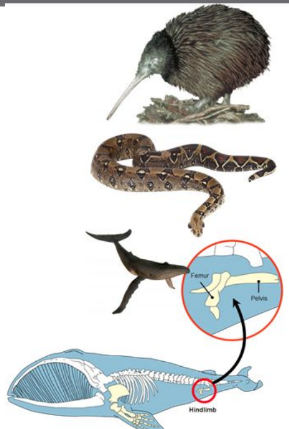
28
New cards
Comparative embryology
During embryonic development, very different organisms show similar structures from earlier stages in their evolutionary development. This is evidence for common ancestry.
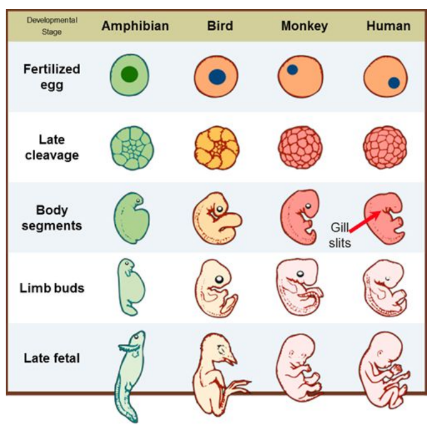
29
New cards
DNA hybridisation
* Amino acid sequences are determined by inherited genes and differences are due to the accumulation of mutations.
* The degree of similarity of these proteins is determined by the number of mutations that have occurred.
* Distantly related species have had more time for differences to accumulate.
* In DNA hybridisation DNA strands can be separated with sufficient heat and will reform (re-anneal) as the temperature falls
* Single-stranded DNA from different species can be mixed together to identify the degree of similarity (as measured by complementary base pairs). Closely related sequences will join together (hybridise) more strongly as they share more complementary base pairs
* The strength of the hybrid molecule (and degree of similarity) can be measured by how much heat is required to separate the strands
* The degree of similarity of these proteins is determined by the number of mutations that have occurred.
* Distantly related species have had more time for differences to accumulate.
* In DNA hybridisation DNA strands can be separated with sufficient heat and will reform (re-anneal) as the temperature falls
* Single-stranded DNA from different species can be mixed together to identify the degree of similarity (as measured by complementary base pairs). Closely related sequences will join together (hybridise) more strongly as they share more complementary base pairs
* The strength of the hybrid molecule (and degree of similarity) can be measured by how much heat is required to separate the strands

30
New cards
Homeobox (Hox) Genes
* The basic structure of many animals is similar - for example, a human, a mouse and a fly all have a head end, a tail end, eyes and limbs.
* The same group of genes provide the instructions for these body parts in all three organisms - the homeobox genes.
* The actual genes that determine the shape and structure of the eye are different, but the gene to grow an eye is the same.
* The same group of genes provide the instructions for these body parts in all three organisms - the homeobox genes.
* The actual genes that determine the shape and structure of the eye are different, but the gene to grow an eye is the same.
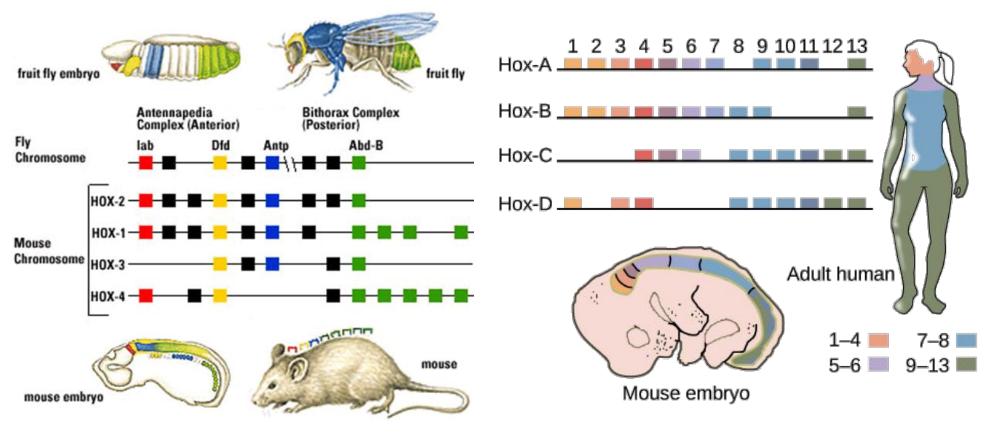
31
New cards
Artificial selection
Artificial selection is the identification by humans of desirable traits in plants and animals, and the steps taken to enhance and perpetuate those traits in future generations.
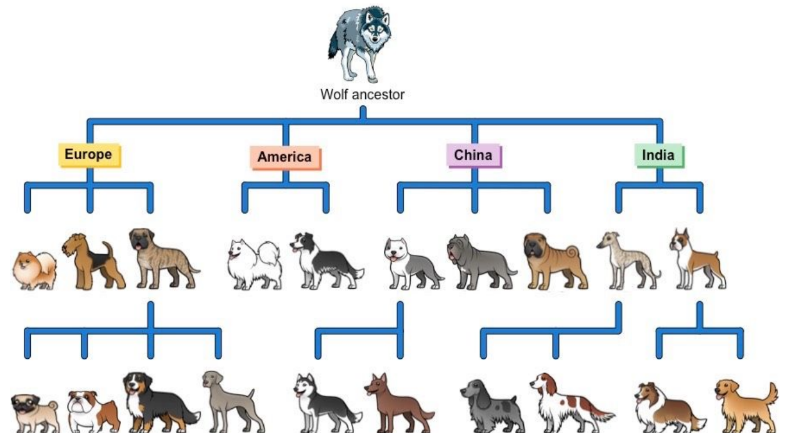
32
New cards
Selective breeding
Selective breeding is a form of artificial selection, whereby humans intervene in the breeding of species to produce desired traits in offspring
33
New cards
Fossil dating techniques
* By examining layers of sedimentary rock, geologists developed a time scale for dividing up earth history.
* Radiometric-dating techniques allowed scientists to put absolute dates on divisions in the geologic time scale.
* Relative dating -- determine whether the rock is older or younger than other rocks (index fossils moment)
* Absolute dating -- use radiometric dating techniques to determine how long ago the rock formed in the exact number of years
* Not all rocks can be dated absolutely, so combinations of techniques are used.
* Radiometric-dating techniques allowed scientists to put absolute dates on divisions in the geologic time scale.
* Relative dating -- determine whether the rock is older or younger than other rocks (index fossils moment)
* Absolute dating -- use radiometric dating techniques to determine how long ago the rock formed in the exact number of years
* Not all rocks can be dated absolutely, so combinations of techniques are used.
34
New cards
Index fossils conditions
Used to define/ identify geological periods
• Distinctive features (E.g., physical characteristics such as shells)
• Widespread over large geographic areas (It’s not just found on one small island for example)
• Abundant/large numbers (increases the chance of some being fossilised when they die)
• Limited in geologic time (provides a narrow time window for comparison)
• Distinctive features (E.g., physical characteristics such as shells)
• Widespread over large geographic areas (It’s not just found on one small island for example)
• Abundant/large numbers (increases the chance of some being fossilised when they die)
• Limited in geologic time (provides a narrow time window for comparison)
35
New cards
5 main fossil types
Petrified:
* The word “petrified” means “turning into stone.”
* Petrified fossils form when minerals replace all or part of an organism.
* Water is full of dissolved minerals. It seeps through the layers of sediment to reach the dead organism. When the water evaporates, only the hardened minerals are left behind.
Mold/ cast
* A mold forms when hard parts of an organism are buried in sediment, such as sand, silt, or clay.
* The hard parts completely dissolve over time, leaving behind a hollow area with the organism’s shape.
* A cast forms as the result of a mold.
Carbon film
* When an organism dies and is buried in sediment, the materials that make up the organism break down.
* Eventually, only carbon remains.
* The thin layer of carbon left behind can show an organism’s delicate parts, like leaves on a plant.
Trace - Trace fossils show the activities of organisms.
Preserved remains:
* Amber
* Tar
* Ice
* The word “petrified” means “turning into stone.”
* Petrified fossils form when minerals replace all or part of an organism.
* Water is full of dissolved minerals. It seeps through the layers of sediment to reach the dead organism. When the water evaporates, only the hardened minerals are left behind.
Mold/ cast
* A mold forms when hard parts of an organism are buried in sediment, such as sand, silt, or clay.
* The hard parts completely dissolve over time, leaving behind a hollow area with the organism’s shape.
* A cast forms as the result of a mold.
Carbon film
* When an organism dies and is buried in sediment, the materials that make up the organism break down.
* Eventually, only carbon remains.
* The thin layer of carbon left behind can show an organism’s delicate parts, like leaves on a plant.
Trace - Trace fossils show the activities of organisms.
Preserved remains:
* Amber
* Tar
* Ice
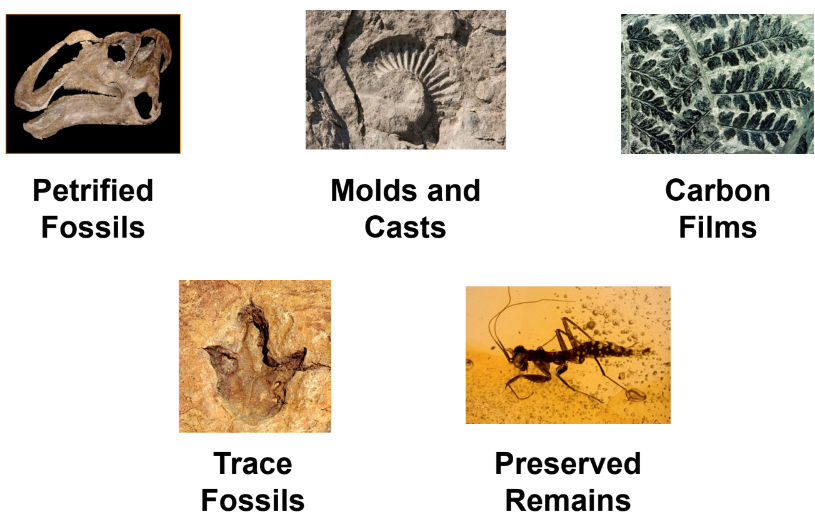
36
New cards
Mechanisms of evolutions
* Gene pools and selection
* Speciation
* Microevolution and macroevolution
* Speciation
* Microevolution and macroevolution
37
New cards
Gene Pools
the sum of all alleles within the genes of a population of a single species.
* Populations with large and diverse gene pools tend to have increased biological
* diverse population often contains enough genetic variation so that there will be an availability of suitable genes that are necessary for survival.
* Populations with narrow gene pools containing low diversity are more likely to suffer from reduced fitness and are more likely to become extinct.
* Populations with large and diverse gene pools tend to have increased biological
* diverse population often contains enough genetic variation so that there will be an availability of suitable genes that are necessary for survival.
* Populations with narrow gene pools containing low diversity are more likely to suffer from reduced fitness and are more likely to become extinct.
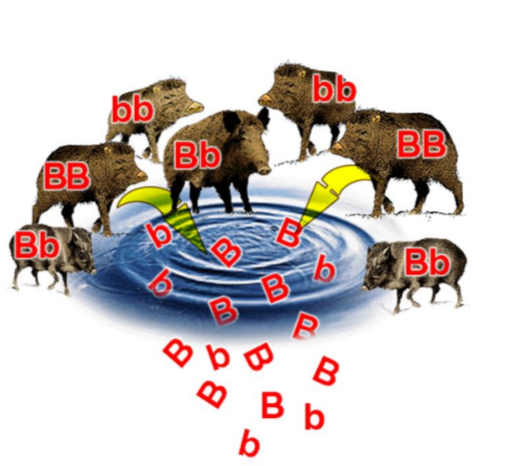
38
New cards
Natural Selection
increases the frequency of characteristics that make individuals better adapted and decreases the frequency of other characteristics leading to changes within the species
* Natural selection may produce phenotypic change over time.
* The direction of change will depend on the selection pressure. (ex Galapagos finches)
* Natural selection may produce phenotypic change over time.
* The direction of change will depend on the selection pressure. (ex Galapagos finches)
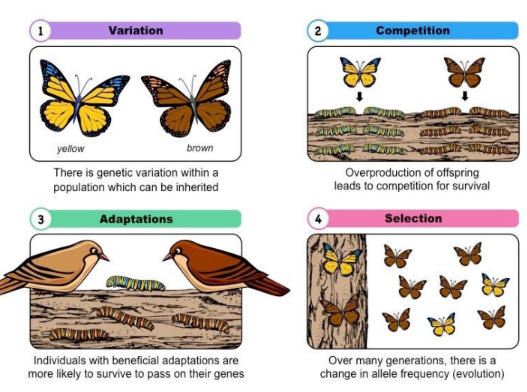
39
New cards
Sexual selection
a type of selection where the presence of a particular trait provides greater success in obtaining mates and reproducing.
* These traits may relate to fitness (for example bigger, stronger males), but in some cases they could actually be counterproductive to survivability (for example bright plumage in birds that makes them more visible to predators).
* It can lead to a situation referred to as non-random mating, where not all individuals have the same opportunity to pass on their alleles/genes.
* These traits may relate to fitness (for example bigger, stronger males), but in some cases they could actually be counterproductive to survivability (for example bright plumage in birds that makes them more visible to predators).
* It can lead to a situation referred to as non-random mating, where not all individuals have the same opportunity to pass on their alleles/genes.
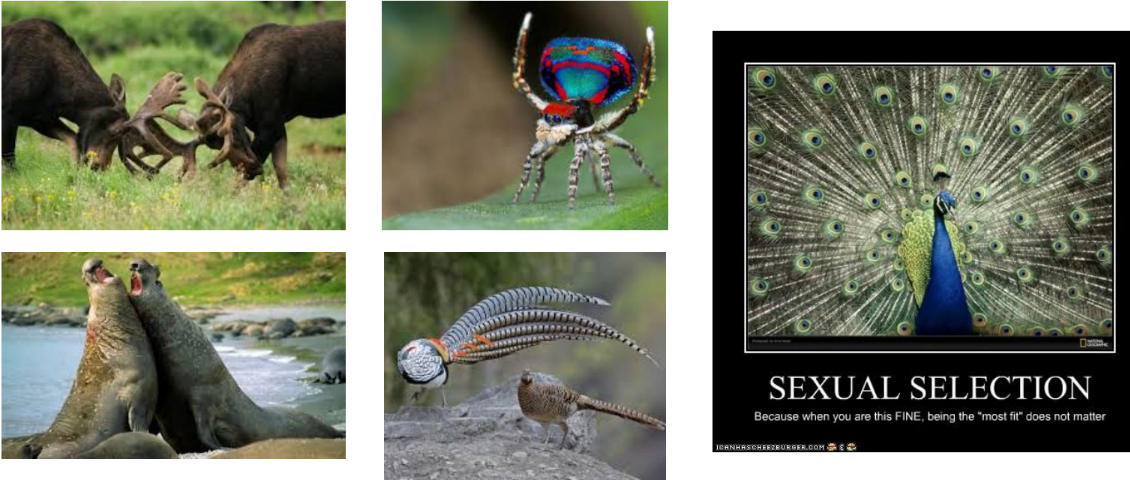
40
New cards
Artificial selection
Artificial selection is the identification by humans of desirable traits in plants and animals, and the steps taken to enhance and perpetuate those traits in future generations.
41
New cards
Effects of selection
Phenotypic distribution:
* Stabilising selection
* Directional selection
* Disruptive selection
* Stabilising selection
* Directional selection
* Disruptive selection
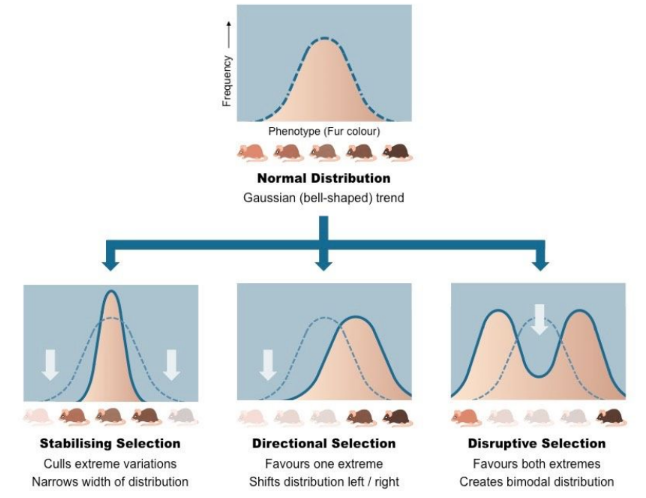
42
New cards
Stabilising Selection
* Ex human birth weight
* Lower and higher birth weights aren’t rlly favourable
* Lower and higher birth weights aren’t rlly favourable
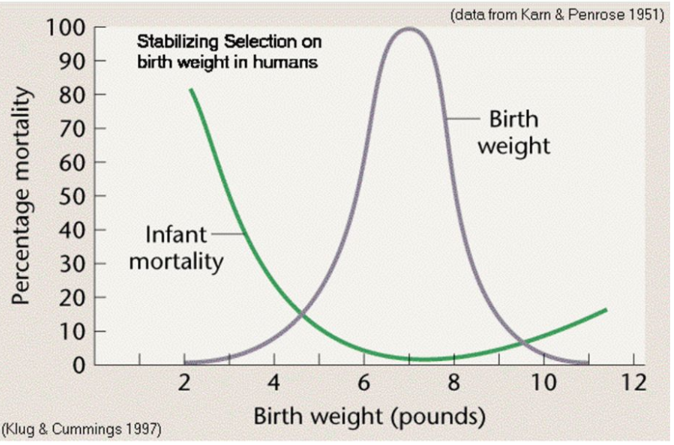
43
New cards
Directional selection
Certain phenotypes are more favourable so phenotypic expression gradually shifts to one side (ex peppered moths)
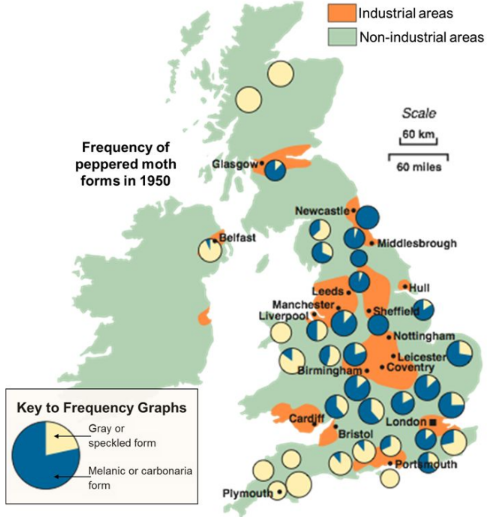
44
New cards
Disruptive Selection
Individuals at both extremes of a phenotypic range are favoured over intermediate variants (two peaks).
* Disruptive selection may occur when environmental conditions are varied or when the environmental range of an organism is large.
* This can lead to speciation.
* Disruptive selection may occur when environmental conditions are varied or when the environmental range of an organism is large.
* This can lead to speciation.
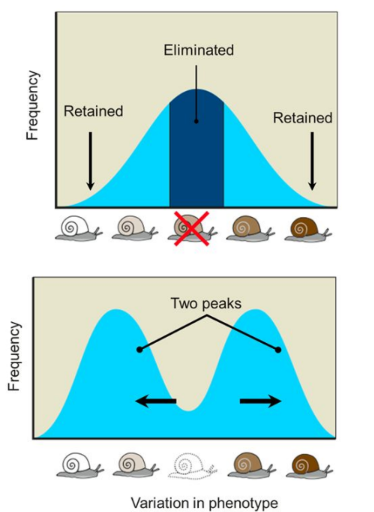
45
New cards
Mutations as allele source
* Mutations can therefore change the frequency of existing alleles by competing with them.
* Recurrent spontaneous mutations may become common in a population if they are not harmful and are not eliminated.
* Recurrent spontaneous mutations may become common in a population if they are not harmful and are not eliminated.
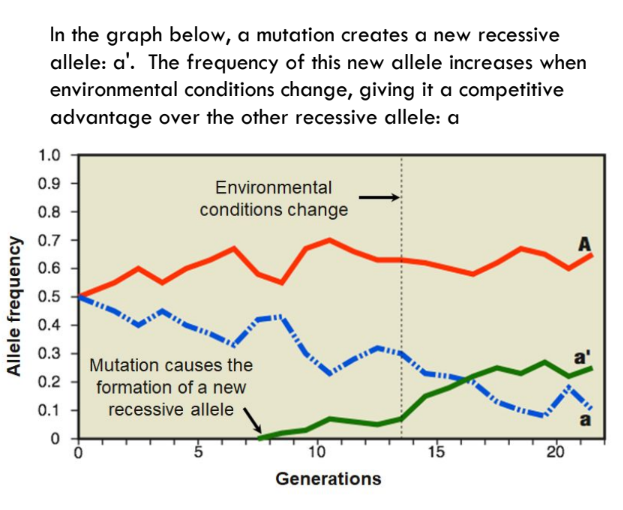
46
New cards
Genetic drift
* Due to random chance, not all individuals in a gene pool pass on their genes to the next generation.
* causes random changes in the gene frequencies.
* Alleles may become: Lost Fixed (present in all individuals)
* Greater in small populations.
* Although genetic drift is a mechanism of evolution, it doesn't work to produce adaptations.
* causes random changes in the gene frequencies.
* Alleles may become: Lost Fixed (present in all individuals)
* Greater in small populations.
* Although genetic drift is a mechanism of evolution, it doesn't work to produce adaptations.
47
New cards
Founder effect
* When a small number of individuals migrate away or become isolated from their original population they will have a small and probably non-representative sample of alleles from the parent population’s gene pool.
* The colonizing population may evolve in a different direction than the parent population.
* The colonizing population may evolve in a different direction than the parent population.

48
New cards
Population bottleneck
* This occurs when the breeding population is reduced by 50% or more.
* Population bottlenecks increase genetic drift, as the rate of drift is inversely proportional to the population size. They also decrease genetic diversity.
* Population bottlenecks increase genetic drift, as the rate of drift is inversely proportional to the population size. They also decrease genetic diversity.
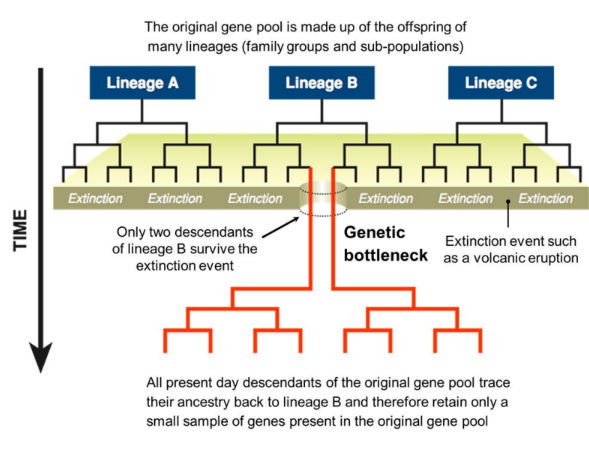
49
New cards
Co-evolution
When 2+ species affect each others evolution
50
New cards
Speciation
A species is a group of organisms able to interbreed and produce fertile offspring.
A population of one species can only evolve into more than one species if groups within the population become isolated from each other by barriers that prevent exchange of genes (gene flow).
A population of one species can only evolve into more than one species if groups within the population become isolated from each other by barriers that prevent exchange of genes (gene flow).
51
New cards
Types of genetic isolation
* Prezygotic isolation – occurs before fertilisation can occur (no offspring are produced)
* Postzygotic isolation – occurs after fertilisation (offspring are either not viable or infertile)
* Postzygotic isolation – occurs after fertilisation (offspring are either not viable or infertile)
52
New cards
Pre-zygotic isolating mechanisms
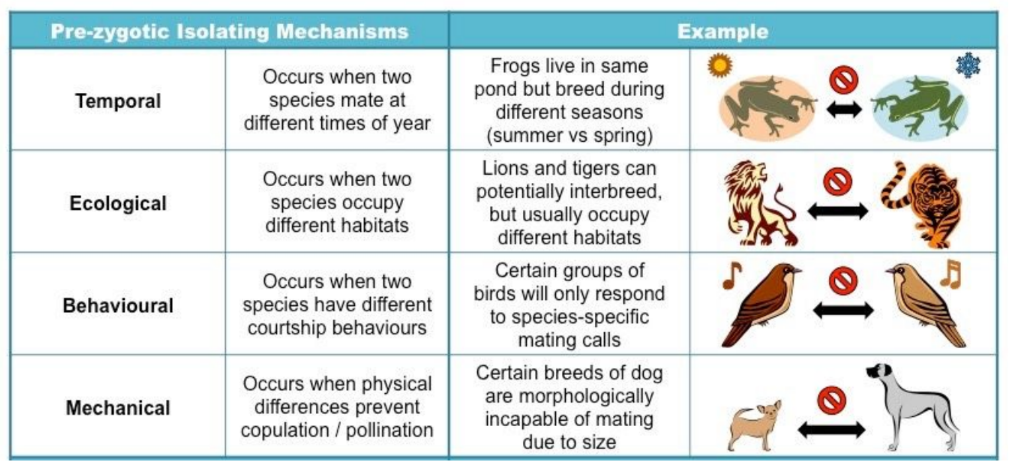
53
New cards
Post-zygotic isolating mechanisms
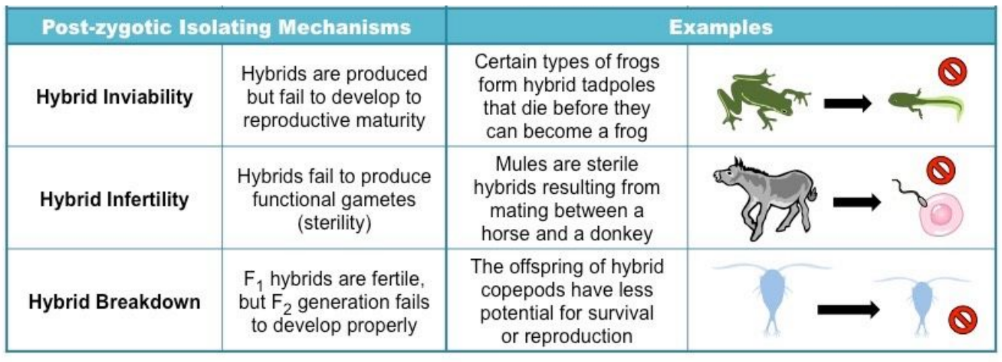
54
New cards
Allopatric speciation
Occurs when a physical barrier divides a population.
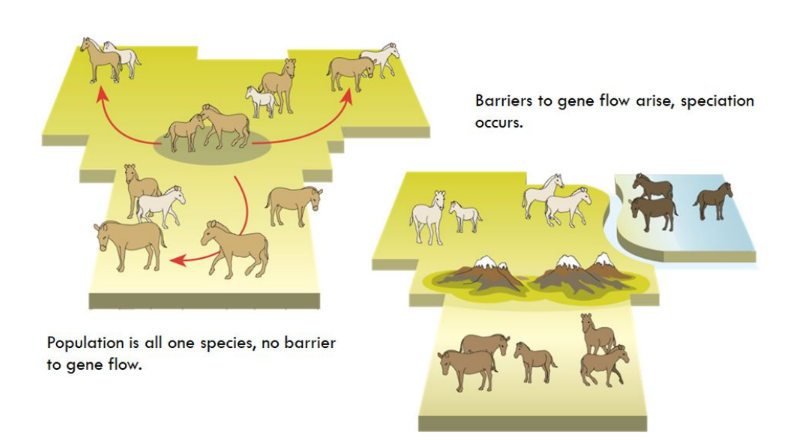
55
New cards
Sympatric speciation
Occurs when species within the same area become reproductively isolated, usually due to some sort of behavioural change.
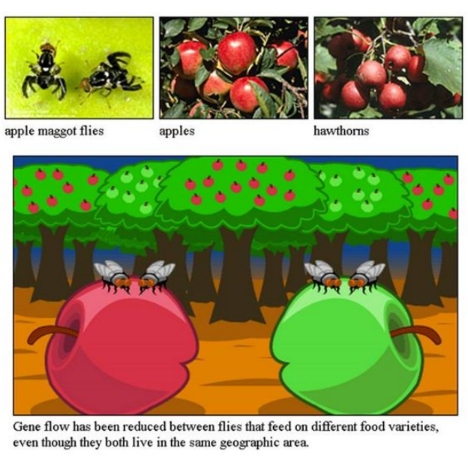
56
New cards
Splitting vs budding
* Splitting: A species could split into two populations that evolve differently until they eventually become separate species.
* Budding: A small part of the species population could “bud off” from the main part and evolve rapidly to form a new species.
* Budding: A small part of the species population could “bud off” from the main part and evolve rapidly to form a new species.

57
New cards
Divergent evolution
Divergent evolution occurs when a common ancestral species evolves into a number of new species. These species have adaptations allowing them to occupy different niches.
(adaptive radiation is a good example)
(adaptive radiation is a good example)

58
New cards
Convergent evolution
Where similar niches and selection pressures exist, species without a recent common ancestry may evolve to have similar physical characteristics, to suit the similar environment.
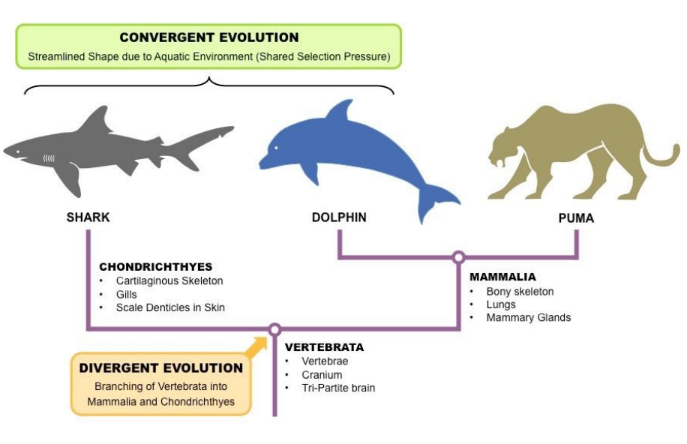
59
New cards
Phyletic Gradualism vs punctuated equilibrium
**Phyletic gradualism:** If the environment remains stable, organisms may undergo very little change over time and evolution is slow and gradual.
* The process is considered a smooth and continuous process and any big changes are the result of the accumulation of many small changes over a long period of time.
* An example might be the slow evolution of the modern horse from ancestral species.
**Punctuated equilibrium:** After long periods with little or no change, an isolation event separates a small population of individuals. With a different gene pool or a burst of mutations, this isolated group rapidly evolves into a separate species.
* The process is considered a smooth and continuous process and any big changes are the result of the accumulation of many small changes over a long period of time.
* An example might be the slow evolution of the modern horse from ancestral species.
**Punctuated equilibrium:** After long periods with little or no change, an isolation event separates a small population of individuals. With a different gene pool or a burst of mutations, this isolated group rapidly evolves into a separate species.
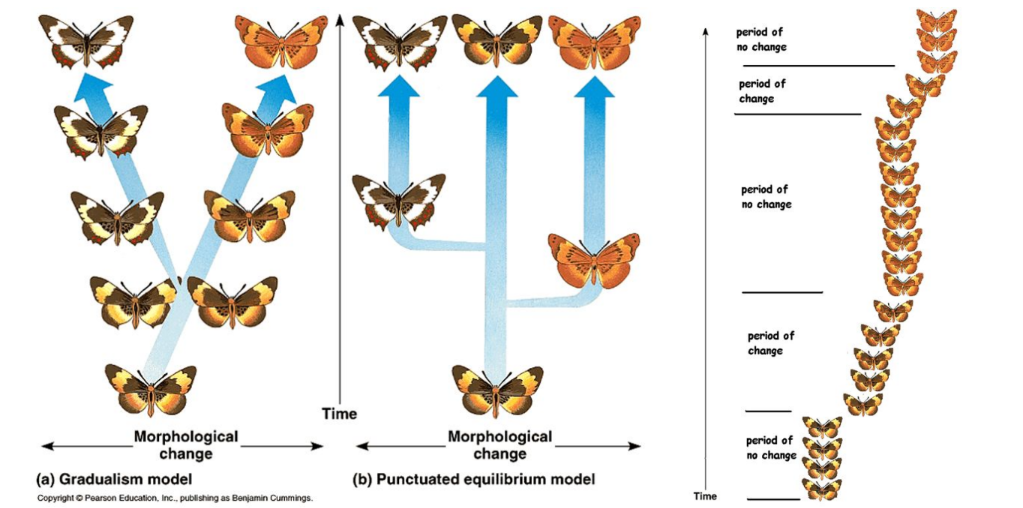
60
New cards
Microevolution - Include mechanisms
* describes evolutionary changes that occur over a relatively short period of geologic time (such as between generations) and results in diversification within a species
* Microevolution is evolution in a single population.
* It works within a group of organisms that interbreed with each other and share a gene pool.
* It can be detected through changes in gene frequency over time.
* The mechanisms for microevolution can directly affect gene frequencies in a population. These include:
* Mutations
* Gene flow
* Genetic drift
* Selection
* Microevolution is evolution in a single population.
* It works within a group of organisms that interbreed with each other and share a gene pool.
* It can be detected through changes in gene frequency over time.
* The mechanisms for microevolution can directly affect gene frequencies in a population. These include:
* Mutations
* Gene flow
* Genetic drift
* Selection

61
New cards
Macroevolution - include patterns
* Macroevolution is evolution on a large scale over longer periods of time, generally above the species level.
* Macroevolution encompasses larger trends and transformations in evolution, such as the origin of mammals and the radiation of flowering plants.
* The basic mechanisms of microevolution - mutation, gene flow, genetic drift, and natural selection - can produce macroevolutionary change if given enough time.
* Some macroevolution patterns include:
* Stasis - some lineages remain unchanged for long periods of time
* Characteristic changes - for example gaining or losing body parts
* Speciation - the rate and frequency at which branching occurs
* Extinctions - this can be rare, frequent, or across many lineages (mass extinction events)
* Macroevolution encompasses larger trends and transformations in evolution, such as the origin of mammals and the radiation of flowering plants.
* The basic mechanisms of microevolution - mutation, gene flow, genetic drift, and natural selection - can produce macroevolutionary change if given enough time.
* Some macroevolution patterns include:
* Stasis - some lineages remain unchanged for long periods of time
* Characteristic changes - for example gaining or losing body parts
* Speciation - the rate and frequency at which branching occurs
* Extinctions - this can be rare, frequent, or across many lineages (mass extinction events)
62
New cards
Population genetics
the study of genetic variation within populations, and involves the examination and modelling of changes in the frequencies of genes and alleles in populations over space and time.
63
New cards
Hardy-Weinberg equilibrium
A principle stating that the genetic variation in a population will remain constant from one generation to the next in the absence of disturbing factors.
When mating is random in a large population with no disruptive circumstances, the law predicts that both genotype and allele frequencies will remain constant because they are in equilibrium.
When mating is random in a large population with no disruptive circumstances, the law predicts that both genotype and allele frequencies will remain constant because they are in equilibrium.
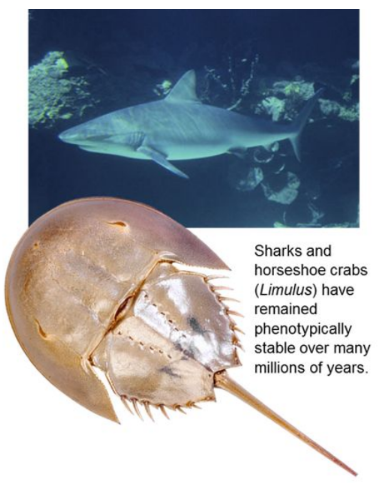
64
New cards
Disruptive factors to Hardy Weinberg equilibrium
The Hardy-Weinberg equilibrium can be disturbed by a number of forces including:
* Mutations - adds new alleles and is a source of variation
* Natural selection - can increase or decrease certain phenotypes
* Non-random mating (sexual selection) - not all individuals will get to pass their alleles on to the next generation
* Genetic drift - can randomly alter allele frequencies
* Gene flow - can add or remove alleles in a population
* Mutations - adds new alleles and is a source of variation
* Natural selection - can increase or decrease certain phenotypes
* Non-random mating (sexual selection) - not all individuals will get to pass their alleles on to the next generation
* Genetic drift - can randomly alter allele frequencies
* Gene flow - can add or remove alleles in a population
65
New cards
Cladistics
method of classifying organisms into groups of species called clades (from Greek ‘klados' = branch)
66
New cards
Clades
Each clade consists of an ancestral organism and all of its evolutionary descendants Members of a clade will possess common characteristics as a result of their shared evolutionary lineage
* Clades can be organised according to branching diagrams (cladograms) in order to show evolutionary relationships
* Clades can be organised according to branching diagrams (cladograms) in order to show evolutionary relationships
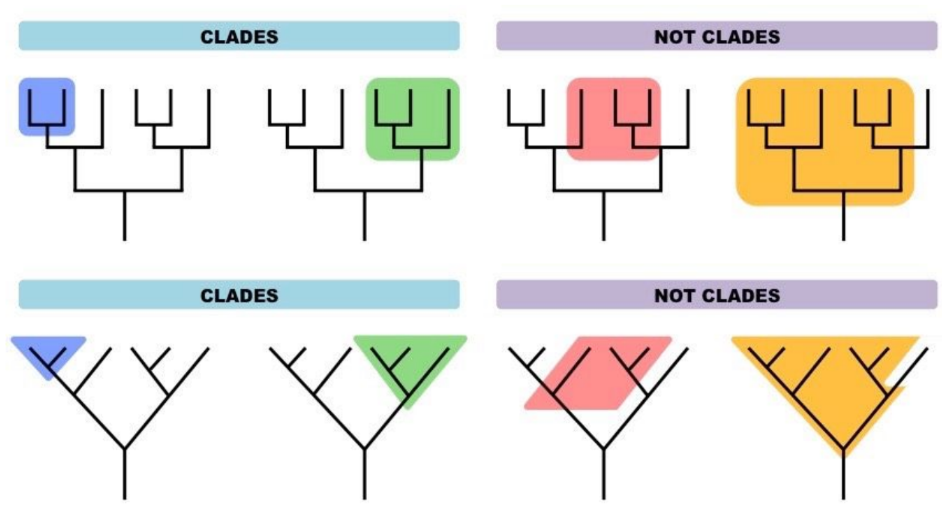
67
New cards
Cladograms
* Constructed cladograms all typically share certain key features:
* Root – The initial ancestor common to all organisms within the cladogram (incoming line shows it originates from a larger clade)
* Nodes – Each node corresponds to a hypothetical common ancestor that speciated to give rise to two (or more) daughter taxa \\
* Outgroup – The most distantly related species in the cladogram which functions as a point of comparison and reference group
* Clades – A common ancestor and all of its descendants (i.e. a node and all of its connected branches)
* Root – The initial ancestor common to all organisms within the cladogram (incoming line shows it originates from a larger clade)
* Nodes – Each node corresponds to a hypothetical common ancestor that speciated to give rise to two (or more) daughter taxa \\
* Outgroup – The most distantly related species in the cladogram which functions as a point of comparison and reference group
* Clades – A common ancestor and all of its descendants (i.e. a node and all of its connected branches)

68
New cards
Phylogeny
Evolutionary history
69
New cards
Molecular evidence
\
* When comparing molecular sequences, scientists may use:
* Non-coding DNA
* Gene sequences
* Amino acid sequences
* Non-coding DNA gives the best means of comparison (mutations occur more regularly) → base change in other sequences affect proteins
* Amino acid sequences used to compare distantly related species
* RNA/DNA used to compare closely related organisms
* When comparing molecular sequences, scientists may use:
* Non-coding DNA
* Gene sequences
* Amino acid sequences
* Non-coding DNA gives the best means of comparison (mutations occur more regularly) → base change in other sequences affect proteins
* Amino acid sequences used to compare distantly related species
* RNA/DNA used to compare closely related organisms
70
New cards
Molecular clocks
\
* Genes/ protein sequences may mutate at *relatively* constant rates
* If ROC is reliable, scientists calculate divergence time according to differences
Limitations:
* Different genes change at different rates
* ROC may differe between different organism groups
* ROC is non-linear → changes may be reversed
* Genes/ protein sequences may mutate at *relatively* constant rates
* If ROC is reliable, scientists calculate divergence time according to differences
Limitations:
* Different genes change at different rates
* ROC may differe between different organism groups
* ROC is non-linear → changes may be reversed
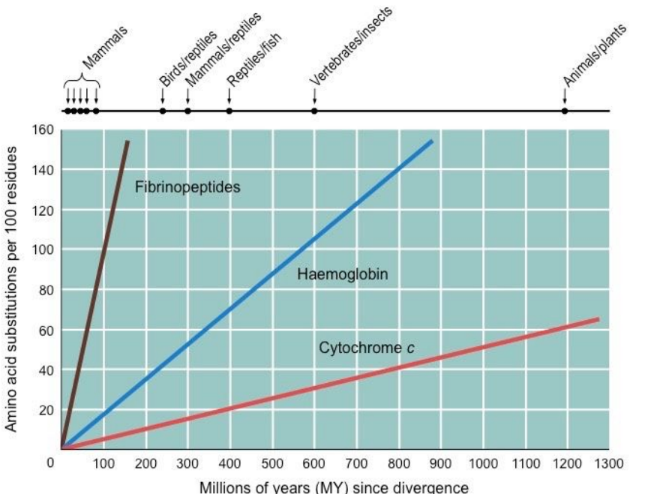
71
New cards
Evolution of organisms - Plants
* Evolved from green algae (likely from charophytes)
* Why? Bc similarities in chlorophyll, chloroplasts, cell walls and DNA
* Steps required for evolution
* Transition from water to land
* Vascular tissue
* Seed evolution
* Diversification of the angiosperms
* Pros:
* Harsh environment
* Heat
* Desiccation (drying out)
* UV radiation
* Gravity
* Rewards:
* CO2
* Sun
* No competition/ herbivores
* Why? Bc similarities in chlorophyll, chloroplasts, cell walls and DNA
* Steps required for evolution
* Transition from water to land
* Vascular tissue
* Seed evolution
* Diversification of the angiosperms
* Pros:
* Harsh environment
* Heat
* Desiccation (drying out)
* UV radiation
* Gravity
* Rewards:
* CO2
* Sun
* No competition/ herbivores
72
New cards
Evolution of organisms - Animals (p1)
Features:
* Multicellular organisms
* Heterotrophic
* No cell walls
* Often mobile
Evolution
* Approximately 900-1000mya single celled organisms, like choanoflagellates, formed colonies consisting of individuals
* Diversified between 500-1000mya
* Exoskeleton development → structural support/ protection
* Vertebrates (notochords from jawless fish) → increased agility/ movement speed
* Jaw → food availability / predation
* Skeleton → Further increased speed/ agility
* Multicellular organisms
* Heterotrophic
* No cell walls
* Often mobile
Evolution
* Approximately 900-1000mya single celled organisms, like choanoflagellates, formed colonies consisting of individuals
* Diversified between 500-1000mya
* Exoskeleton development → structural support/ protection
* Vertebrates (notochords from jawless fish) → increased agility/ movement speed
* Jaw → food availability / predation
* Skeleton → Further increased speed/ agility
73
New cards
Evolution of animals - terrestrial
Adaptations required
* Temperature changes
* Air breathing
* Structural support
* Dehydration
* Reproduction
* UV radiation
\
* Amphibians
* likely evolved from lobe finned fish ancestor in shallow environments
* Moist skin for O2 diffusion, lungs and amniotic eggs
* Ectothermic (cant regulate body temp)
* Reptiles
* Kertain forming scales (waterproof), amniotic membrane + soft shelled eggs
* ectothermic
* Dinosaur extinction
* Birds
* Modified scales → feathers
* Hollow bones
* Elongated metaCARPALS
* Wishbone
* Sternal Keel
* Air sacs + lungs
* Limited organs (save weight)
* Hard shelled eggs
* Keratin beaks
* Mammals
* Early likely from nocturnal monotremes
* fur (keratin)
* Warm blooded
* Live young (except monotremes)
* Suckle young w milk
* Dentition - adaptive teeth
* Temperature changes
* Air breathing
* Structural support
* Dehydration
* Reproduction
* UV radiation
\
* Amphibians
* likely evolved from lobe finned fish ancestor in shallow environments
* Moist skin for O2 diffusion, lungs and amniotic eggs
* Ectothermic (cant regulate body temp)
* Reptiles
* Kertain forming scales (waterproof), amniotic membrane + soft shelled eggs
* ectothermic
* Dinosaur extinction
* Birds
* Modified scales → feathers
* Hollow bones
* Elongated metaCARPALS
* Wishbone
* Sternal Keel
* Air sacs + lungs
* Limited organs (save weight)
* Hard shelled eggs
* Keratin beaks
* Mammals
* Early likely from nocturnal monotremes
* fur (keratin)
* Warm blooded
* Live young (except monotremes)
* Suckle young w milk
* Dentition - adaptive teeth
74
New cards
Primate evolution + features
\
A primate ancestor would have had the following features:
* Arboreal (tree dwelling) habit
* Grasping hands and feet
* Long, mobile limbs
* Quadrupedal locomotion
* Binocular vision
* Upright sitting position
* Nails instead of claws on most digits
Primates have a combination of features that are unique to their group. Their anatomy is well adapted to an arboreal (tree- dwelling) lifestyle. They possess:
* Superior intelligence
* Often complex social behaviour
* A highly developed problem solving ability
A primate ancestor would have had the following features:
* Arboreal (tree dwelling) habit
* Grasping hands and feet
* Long, mobile limbs
* Quadrupedal locomotion
* Binocular vision
* Upright sitting position
* Nails instead of claws on most digits
Primates have a combination of features that are unique to their group. Their anatomy is well adapted to an arboreal (tree- dwelling) lifestyle. They possess:
* Superior intelligence
* Often complex social behaviour
* A highly developed problem solving ability
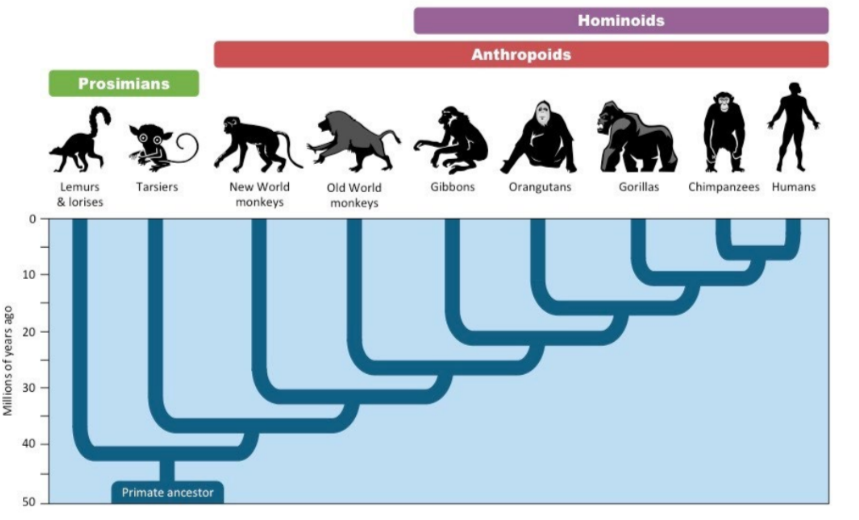
75
New cards
Hominids vs hominins
**hominids**
The group consisting of all modern and extinct Great Apes. Anatomical features common to all hominids:
* No tail
* Semi-erect or fully erect posture
* Broad chest, pelvis, and shoulders
* Relatively long arms and mobile shoulder joints
* Large brain
* Examples:
* Human
* Chimpanzee
* Gorilla
**Hominins**
The group consisting of modern humans, extinct human species and all our immediate ancestors. Anatomical features and habits:
* Bipedal with modified feet, thigh bone, pelvis, and spine
* Large cerebral cortex (forebrain)
* Reduced canines (and teeth in general)
* Prominent nose and chin, reduced eye ridges
* Body hair short or very reduced
* Highly sensitive skin
* Complex social behaviour
* Examples:
* Australopithecus
* Paranthropus
* Homo
The group consisting of all modern and extinct Great Apes. Anatomical features common to all hominids:
* No tail
* Semi-erect or fully erect posture
* Broad chest, pelvis, and shoulders
* Relatively long arms and mobile shoulder joints
* Large brain
* Examples:
* Human
* Chimpanzee
* Gorilla
**Hominins**
The group consisting of modern humans, extinct human species and all our immediate ancestors. Anatomical features and habits:
* Bipedal with modified feet, thigh bone, pelvis, and spine
* Large cerebral cortex (forebrain)
* Reduced canines (and teeth in general)
* Prominent nose and chin, reduced eye ridges
* Body hair short or very reduced
* Highly sensitive skin
* Complex social behaviour
* Examples:
* Australopithecus
* Paranthropus
* Homo
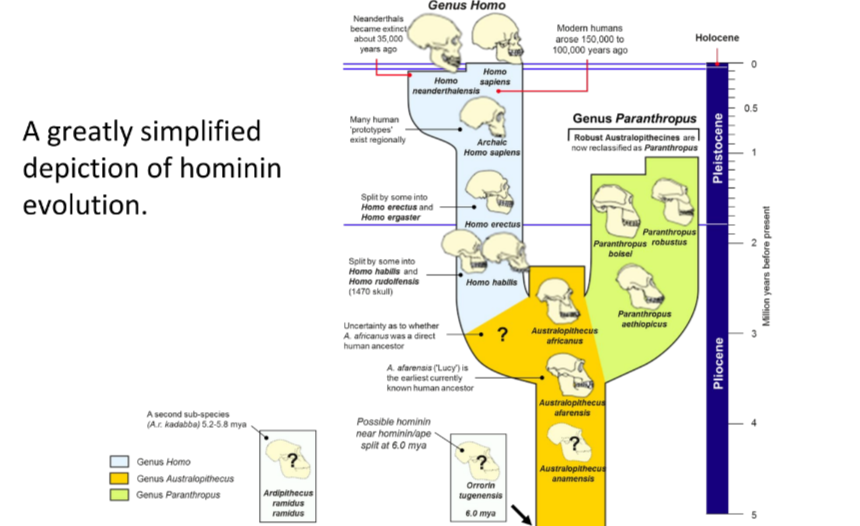
76
New cards
Human characteristics
* Bipedalism
* Larger brains
* Increased intelligence
* Teeth changes
* Loss of body hair
* Larger brains
* Increased intelligence
* Teeth changes
* Loss of body hair
77
New cards
Adaptations for Bipedalism
* Forward pointing big toe
* Transverse arch to absorb impact
* Foramen magnum at base of skull
* Carrying angle of femur
* Strong knee joint
* Lower & broader pelvis
* Strong gluteal muscles
* Transverse arch to absorb impact
* Foramen magnum at base of skull
* Carrying angle of femur
* Strong knee joint
* Lower & broader pelvis
* Strong gluteal muscles
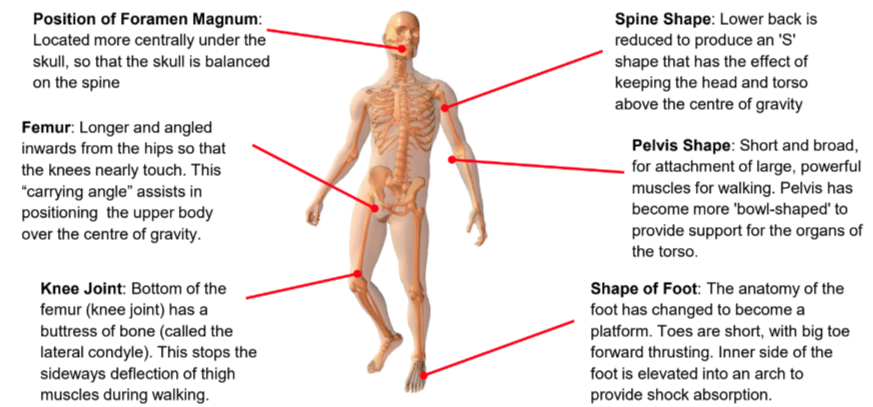
78
New cards
Selection pressures for bipedalism
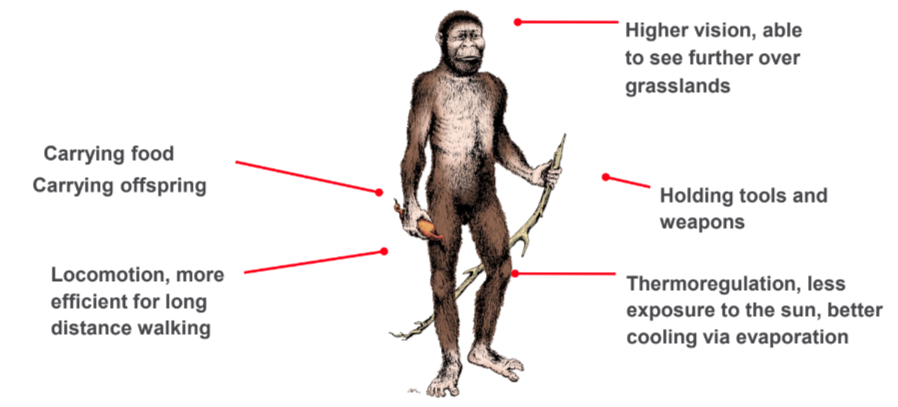
79
New cards
Australopithecines
As many as four species of genus Australopithecus existed, ranging from southern Africa, through East Africa, to Chad in the north.
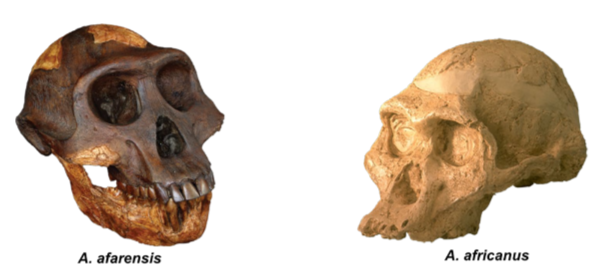
80
New cards
Australopithecus afarensis
* ‘Lucy’
* 4.0-2.7 mya
* Bipedal, walked erect, but also arboreal
* Human-like hands and teeth
* Brain capacity of about 375-550 cc
* Apelike face with a sloping forehead, a distinct ridge over the eyes, flat nose and a chinless lower jaw
* Between 1.0m and 1.5m tall (sexual dimorphism)
* 4.0-2.7 mya
* Bipedal, walked erect, but also arboreal
* Human-like hands and teeth
* Brain capacity of about 375-550 cc
* Apelike face with a sloping forehead, a distinct ridge over the eyes, flat nose and a chinless lower jaw
* Between 1.0m and 1.5m tall (sexual dimorphism)
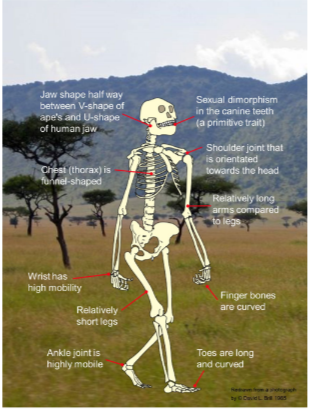
81
New cards
Genus Paranthropus
Paranthropus were a group of species that exploited low-grade vegetable food sources (nuts, root tubers and seeds) resulting in (megadont) species with very large teeth.
\
* Went extinct though
\
* Went extinct though
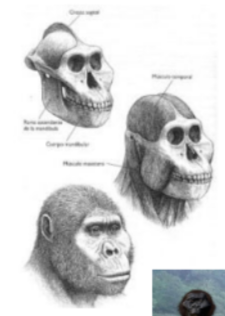
82
New cards
Homo Erectus
H. habilis → H. ergaster → H. erectus
2 mya - 400 000 ya
* Early examples had a 850cc brain size, which increased to 1100cc
* The species definitely had speech (enlarged Broca’s area, region of brain for speech, and structure of jaw & throat)
* H. erectus developed tools, weapons and fire and learned to cook food
* Face had massive jaws with huge molars, no chin, thick brow ridges, and a long low skull
* Sturdier in build and much stronger than the modern human
2 mya - 400 000 ya
* Early examples had a 850cc brain size, which increased to 1100cc
* The species definitely had speech (enlarged Broca’s area, region of brain for speech, and structure of jaw & throat)
* H. erectus developed tools, weapons and fire and learned to cook food
* Face had massive jaws with huge molars, no chin, thick brow ridges, and a long low skull
* Sturdier in build and much stronger than the modern human

83
New cards
Adaptations for running
* Loss of hair, sweat for cooling, high SA:V
* Elongated legs
* Nuchal ligament (back of neck) stabilises head
* Thickened joint surfaces in knees and other high impact joints
* Plantar arch in foot acts as a spring
* Achilles tendon
* Well developed gluteus maximus
* More muscles attached to the lower spine for support
* Elongated legs
* Nuchal ligament (back of neck) stabilises head
* Thickened joint surfaces in knees and other high impact joints
* Plantar arch in foot acts as a spring
* Achilles tendon
* Well developed gluteus maximus
* More muscles attached to the lower spine for support
84
New cards
Selection For Reduced Body Hair
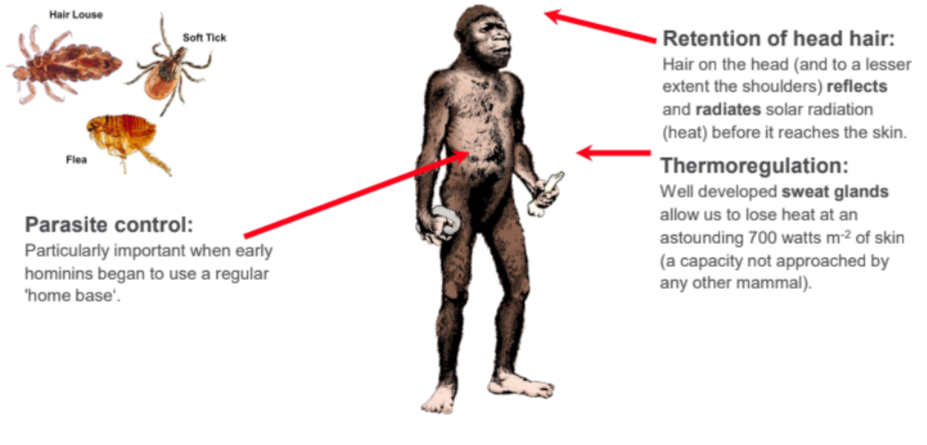
85
New cards
Evolution of the Human Brain
* Intelligence is not just a function of brain size: relative brain size appears to be more important (brain size compared to body size).
* Modern humans have a brain volume three times larger than that predicted for an average monkey or ape with our body size.
* Another important factor is the organization of the brain, evident in the development of the areas concerned with spoken language.
* Two areas of the brain have become highly developed in modern humans:
* Broca’s area concerned with speech
* Wernicke’s area concerned with comprehension of language.
* Modern humans have a brain volume three times larger than that predicted for an average monkey or ape with our body size.
* Another important factor is the organization of the brain, evident in the development of the areas concerned with spoken language.
* Two areas of the brain have become highly developed in modern humans:
* Broca’s area concerned with speech
* Wernicke’s area concerned with comprehension of language.
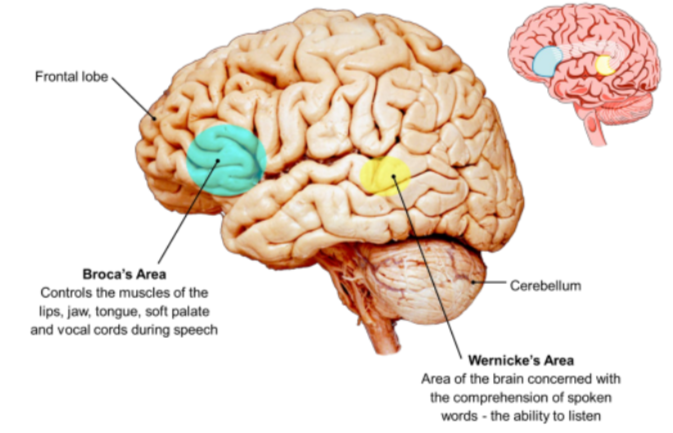
86
New cards
Homo neanderthalensis
* 350 000 - 30 000 ya
* Shorter, more robust frame
* Skull has low forehead, strong brow ridges and occipital bone
* Broad nasal cavity (to warm air)
* Barrel shaped chest and compact body conserve heat
* Evidence of tools, fires, care for injured people, burial customs, music
* Shorter, more robust frame
* Skull has low forehead, strong brow ridges and occipital bone
* Broad nasal cavity (to warm air)
* Barrel shaped chest and compact body conserve heat
* Evidence of tools, fires, care for injured people, burial customs, music

87
New cards
Homo sapiens (also called Cro-Magnon)
* Homo sapiens evolved in Africa - better suited for a hot climate
* Moved into Europe approximately 90,000 ya
* Brain is around 1400cc with a high frontal lobe/forehead
* Complex tools, agriculture, music, art, abstract concepts
* The first anatomically modern humans appear possibly as early as 300,000 years ago in Africa and the Middle East.
* Underwent a sudden cultural revolution about 40 000 years ago, with the appearance of Cro-Magnon culture.
* Using a wider range of materials, their tools kits became markedly more sophisticated.
* They were skilled hunters, tool-makers and artists (cave art and music).
* Moved into Europe approximately 90,000 ya
* Brain is around 1400cc with a high frontal lobe/forehead
* Complex tools, agriculture, music, art, abstract concepts
* The first anatomically modern humans appear possibly as early as 300,000 years ago in Africa and the Middle East.
* Underwent a sudden cultural revolution about 40 000 years ago, with the appearance of Cro-Magnon culture.
* Using a wider range of materials, their tools kits became markedly more sophisticated.
* They were skilled hunters, tool-makers and artists (cave art and music).
